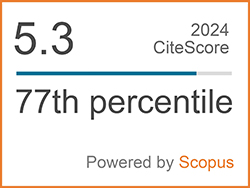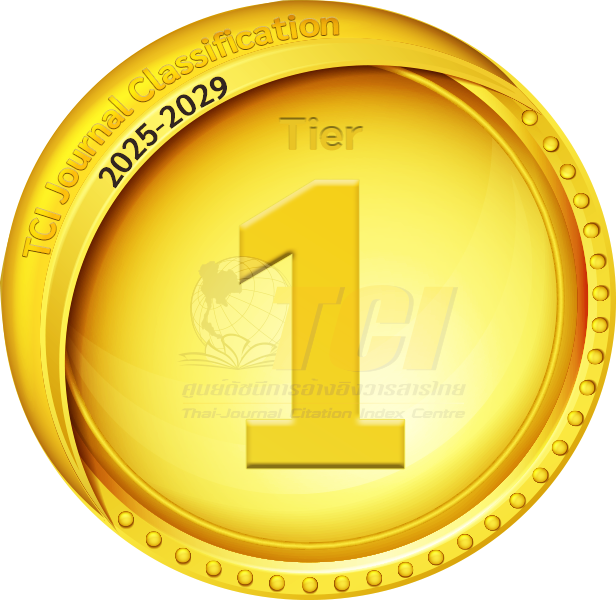Role of Activated Carbon from Arabica Coffee Waste in Enhancing the Dehydrogenation Properties of Magnesium Hydride (MgH2) for Hydrogen Storage
Abstract
Keywords
[1] K. Chawla, D. K. Yadav, P. Sharda, N. Lal, S. Sharma, and C. Lal, “Hydrogenation properties of MgH2- x wt% AC (x=0, 5, 10, 15) nanocomposites,” International Journal of Hydrogen Energy, vol. 45, no. 44, pp. 23971–23976, 2020, doi: 10.1016/j.ijhydene.2019.09.022.
[2] K. L. Lim, H. Kazemian, Z. Yaakob, and W. R. W. Daud, “Solid-state materials and methods for hydrogen storage: A critical review,” Chemical Engineering and Technology, vol. 33, no. 2, pp. 213–226, 2010, doi: 10.1002/ceat.200900376.
[3] J. A. Bolarin, R. Zou, Z. Li, A. Munyentwali, Z. Zhang, and H. Cao, “Recent path to ultrafine Mg/MgH2 synthesis for sustainable hydrogen storage,” International Journal of Hydrogen Energy, vol. 52, pp. 251–274, 2023, doi: 10.1016/j.ijhydene.2023.04.234.
[4] L. E. Klebanoff, K. C. Ott, L. J. Simpson, K. O’Malley, and N. T. Stetson, “Accelerating the understanding and development of hydrogen storage materials: A review of the five-year efforts of the three DOE hydrogen storage materials centers of excellence,” Metallurgical and Materials Transactions E, vol. 1, no. 2, pp. 81–117, 2014, doi: 10.1007/s40553-014-0011-z.
[5] M. R. Usman, “Hydrogen storage methods: Review and current status,” Renewable and Sustainable Energy Reviews, vol. 167, Oct. 2022, Art. no. 112743, doi: 10.1016/j.rser.2022. 112743.
[6] M. Yang, R. Hunger, S. Berrettoni, B. Sprecher, and B. Wang, “A review of hydrogen storage and transport technologies,” Clean Energy, vol. 7, no. 1, pp. 190–216, Feb. 2023, doi: 10.1093/ce/ zkad021.
[7] L. Mulky, S. Srivastava, T. Lakshmi, E. R. Sandadi, S. Gour, N. A. Thomas, S. S. Priya, and K. Sudhakar, “An overview of hydrogen storage technologies – Key challenges and opportunities,” Materials Chemistry and Physics, vol. 325, Oct. 2024, Art. no. 129710, doi: 10.1016/j.matchemphys. 2024.129710.
[8] N. A. Ali and M. Ismail, “Advanced hydrogen storage of the Mg–Na–Al system: A review,” Journal of Magnesium and Alloys, vol. 9, no. 4, pp. 1111–1122, 2021, doi: 10.1016/j.jma.2021. 03.031.
[9] Malahayati, Nurmalita, Ismail, M. N. Machmud, and Z. Jalil, “Sorption behavior of MgH2-Ti for Hydrogen storage material prepared by high pressure milling,” Journal of Physics: Conference Series, vol. 1882, no. 1, May 2021, Art. no. 012005, doi: 10.1088/1742-6596/1882/1/012005.
[10] A. Setiawan, B. B. Sitepu, M., K. Anshar, S. Riskina, S. Nurjannah, and L. Hakim, “Converting arabica coffee parchment into value-added products: Technical and economic assessment,” Coffee Science, 2024, Art. no. e192185, doi: 10.25186/.v19i.2185.
[11] A. H. Sarosa, V. Nurhadianty, N. H. F. Naufal Dian, F. N. Anita, A. F. Noerdinna, and S. D. Ainur Rizqy, “The kinetic study of dampit robusta coffee caffeine degradation by Saccharomyces cerevisiae,” Applied Science and Engineering Progress, vol. 17, no. 1, Jul. 2023, Art. no. 6891, doi: 10.14416/j.asep.2023.07.004.
[12] B. M. Gouvea, C. Torres, A. S. Franca, L. S. Oliveira, and E. S. Oliveira, “Feasibility of ethanol production from coffee husks,” Biotechnology Letters, vol. 31, no. 9, pp. 1315–1319, Sep. 2009, doi: 10.1007/s10529-009-0023-4.
[13] R. Campos-Vega, G. Loarca-Piña, H. A. Vergara-Castañeda, and B. D. Oomah, “Spent coffee grounds: A review on current research and future prospects,” Trends in Food Science & Technology, vol. 45, no. 1, pp. 24–36, Sep. 2015, doi: 10.1016/j.tifs.2015.04.012.
[14] R. Raihan, A. Setiawan, L. Hakim, Muhammad, M. Arif, and H. Hosseiniamoli, “Preparation and characterization of active charcoal made from robusta coffee skin (Coffea Canephora),” Journal of Chemical Engineering and Enviroment, vol. 15, no. 2, pp. 104–110, 2020, doi: 10.23955/rkl.v15i2.17618.
[15] M. Konarova, A. Tanksale, J. Norberto Beltramini, and G. Qing Lu, “Effects of nano-confinement on the hydrogen desorption properties of MgH2,” Nano Energy, vol. 2, no. 1, pp. 98–104, 2013, doi: 10.1016/j.nanoen.2012. 07.024.
[16] Q. Zhang, Y. Huang, M. Tiancai, K. Li, X. Wang, L. Jiao, H. Yuan, and Y. Wang, “Facile synthesis of small MgH2 nanoparticles confined in different carbon materials for hydrogen storage,” Journal of Alloys and Compounds, vol. 825, pp. 1–9, 2020, doi: 10.1016/j.jallcom.2020. 153953.
[17] H. Jin, Y. S. Lee, and I. Hong, “Hydrogen adsorption characteristics of activated carbon,” Catalysis Today, vol. 120, no. 3–4, pp. 399–406, 2007, doi: 10.1016/j.cattod.2006.09.012.
[18] W. Su, L. Zhou, and Y. Zhou, “Preparation of microporous activated carbon from raw coconut shell by two-step procedure,” Chinese Journal of Chemical Engineering, vol. 14, no. 2, pp. 266–269, Apr. 2006, doi: 10.1016/S1004-9541(06) 60069-4.
[19] N. Nurmalita, R. Raihan, Z. Jalil, S. Nur, and A. Setiawan, “The Physical and chemical properties of activated nanocarbon produced from Robusta (Coffea Canephora) coffee pulp under slow pyrolysis method,” Coffee Science, vol. 17, pp. 1–10, 2023, doi: 10.25186/.v17i.2019.
[20] X. J. Lee, L. Y. Lee, S. Gan, S. Thangalazhy-Gopakumar, and H. K. Ng, “Biochar potential evaluation of palm oil wastes through slow pyrolysis: Thermochemical characterization and pyrolytic kinetic studies,” Bioresource Technology, vol. 236, pp. 155–163, Jul. 2017, doi: 10.1016/ j.biortech.2017.03.105.
[21] S. Schaefer, A. Jeder, G. Sdanghi, P. Gadonneix, A. Abdedayem, M. Izquierdo, G. Maranzana, A. Ouederni, A. Celzard, and V. Fierro, “Oxygen-promoted hydrogen adsorption on activated and hybrid carbon materials,” International Journal of Hydrogen Energy, vol. 45, no. 55, pp. 30767–30782, Nov. 2020, doi: 10.1016/j.ijhydene. 2020.08.114.
[22] K. L. Lim, H. Kazemian, Z. Yaakob, and W. R. W. Daud, “Solid‐state materials and methods for hydrogen storage: A critical review,” Chemical Engineering & Technology, vol. 33, no. 2, pp. 213–226, Feb. 2010, doi: 10.1002/ceat.200900376.
[23] W. Riansa-ngawong, W. Savedboworn, and M. Suwansaard, “Optimization of hydrogen production from pickle bamboo shoot wastewater by Rhodopseudomonas palustris TN1,” KMUTNB International Journal of Applied Science and Technology, vol. 8, no. 3, pp. 205–212, Jul. 2015, doi: 10.14416/j.ijast. 2015.06.004.
[24] N. A. Basha, T. Rathinavel, and H. Sridharan, “Activated carbon from coconut shell: Synthesis and its commercial applications - A recent review,” Applied Science and Engineering Progress, vol. 16, no. 2, Jul. 2023, Art. no. 6152, doi: 10.14416/j.asep.2022.07.001.
[25] M. Mohan, V. K. Sharma, E. A. Kumar, and V. Gayathri, “Hydrogen storage in carbon materials —A review,” Energy Storage, vol. 1, no. 2, Apr. 2019, doi: 10.1002/est2.35.
[26] L. S. Blankenship, N. Balahmar, and R. Mokaya, “Oxygen-rich microporous carbons with exceptional hydrogen storage capacity,” Nature Communications, vol. 8, no. 1, p. 1545, Nov. 2017, doi: 10.1038/s41467-017-01633-x.
[27] G. Sethia and A. Sayari, “Activated carbon with optimum pore size distribution for hydrogen storage,” Carbon, vol. 99, pp. 289–294, Apr. 2016, doi: 10.1016/j.carbon.2015.12.032.
[28] A. Fomkin, A. Pribylov, I. Men’shchikov, A. Shkolin, O. Aksyutin, A. Ishkov, K. Romanov, and E. Khozina, “Adsorption-based hydrogen storage in activated carbons and model carbon structures,” Reactions, vol. 2, no. 3, pp. 209–226, Jul. 2021, doi: 10.3390/reactions2030014.
[29] H. Jin, Y. S. Lee, and I. Hong, “Hydrogen adsorption characteristics of activated carbon,” Catalysis Today, vol. 120, no. 3–4, pp. 399–406, Feb. 2007, doi: 10.1016/j.cattod.2006.09.012.
[30] Z. Fona, Irvan, R. Tambun, Fatimah, and A. Setiawan, “Physico-chemical characteristics of coffee parchment and its combustion residue to delineate the components required for gasification catalyst,” Case Studies in Chemical and Environmental Engineering, vol. 10, Dec. 2024, Art. no. 100991, doi: 10.1016/j.cscee. 2024.100991.
[31] H. Kristianto, A. A. Arie, R. F. Susanti, M. Halim, and J. K. Lee, “The effect of activated carbon support surface modification on characteristics of carbon nanospheres prepared by deposition precipitation of Fe-catalyst,” IOP Conference Series: Materials Science and Engineering, vol. 162, no. 1, Nov. 2016, Art. no. 012034, doi: 10.1088/1757-899X/162/1/012034.
[32] A. P. Craig, A. S. Franca, and L. S. Oliveira, “Discrimination between immature and mature green coffees by attenuated total reflectance and diffuse reflectance fourier transform infrared spectroscopy,” Journal of Food Science, vol. 76, no. 8, 2011, doi: 10.1111/j.1750-3841.2011. 02359.x.
[33] J. Alcañiz-Monge, M. del C. Román-Martínez, and M. Á. Lillo-Ródenas, “Chemical activation of lignocellulosic precursors and residues: what else to consider?,” Molecules, vol. 27, no. 5, p. 1630, Mar. 2022, doi: 10.3390/molecules27051630.
[34] W. M. A. W. Daud, W. S. W. Ali, and M. Z. Sulaiman, “The effects of carbonization temperature on pore development in palm-shell-based activated carbon,” Carbon, vol. 38, no. 14, pp. 1925–1932, 2000, doi: 10.1016/S0008-6223(00)00028-2.
[35] H. Zhang, Y. Yan, and L. Yang, “Preparation of activated carbon from sawdust by zinc chloride activation,” Adsorption, vol. 16, no. 3, pp. 161–166, Aug. 2010, doi: 10.1007/s10450-010-9214-5.
[36] A. Khamkeaw, W. Sanprom, and M. Phisalaphong, “Activated carbon from bacterial cellulose by potassium hydroxide activation as an effective adsorbent for removal of ammonium ion from aqueous solution,” Case Studies in Chemical and Environmental Engineering, vol. 8, Dec. 2023, Art. no. 100499, doi: 10.1016/j.cscee.2023.100499.
[37] G. C. Figueroa, J. Perez, I. Block, S. Sagu, P. C. Saravia, A. Taubert, and H. Rawel, “Preparation of activated carbons from spent coffee grounds and coffee parchment and assessment of their adsorbent efficiency,” Processes, vol. 9, no. 8, p. 1396, Aug. 2021, doi: 10.3390/pr9081396.
[38] Y. Gao, Q. Yue, B. Gao, and A. Li, “Insight into activated carbon from different kinds of chemical activating agents: A review,” Science of The Total Environment, vol. 746, Dec. 2020, Art. no. 141094, doi: 10.1016/j.scitotenv.2020. 141094.
[39] C. H. Chia, S. Zakaria, M. S. Sajab, and M. J. Saad, “Activated carbon produced from rice husk by NaOH and KOH activation and its adsorption in methylene blue,” Advances in Agricultural and Food Research Journal, pp. 1–13, 2022, doi: 10.36877/aafrj.a0000297.
[40] M. Zięzio, B. Charmas, K. Jedynak, M. Hawryluk, and K. Kucio, “Preparation and characterization of activated carbons obtained from the waste materials impregnated with phosphoric acid(V),” Applied Nanoscience, vol. 10, no. 12, pp. 4703–4716, Dec. 2020, doi: 10.1007/s13204-020-01419-6.
[41] J. Jjagwe, P. W. Olupot, E. Menya, and H. M. Kalibbala, “Synthesis and application of granular activated carbon from biomass waste materials for water treatment: A review,” Journal of Bioresources and Bioproducts, vol. 6, no. 4, pp. 292–322, Nov. 2021, doi: 10.1016/j.jobab.2021. 03.003.
[42] A. Świątkowski, E. Kuśmierek, K. Kuśmierek, and S. Błażewicz, “The influence of thermal treatment of activated carbon on its electrochemical, corrosion, and adsorption characteristics,” Molecules, vol. 29, no. 20, p. 4930, Oct. 2024, doi: 10.3390/molecules29204930.
[43] G. Duran-Jimenez, J. Rodriguez, L. Stevens, S. Altarawneh, A. Batchelor, L. Jiang, and C. Dodds., “Single-step preparation of activated carbons from pine wood, olive stones and nutshells by KOH and microwaves: Influence of ultra-microporous for high CO2 capture,” Chemical Engineering Journal, vol. 499, Nov. 2024, Art. no. 156135, doi: 10.1016/j.cej.2024. 156135.
[44] R. Sitthikhankaew, D. Chadwick, S. Assabumrungrat, and N. Laosiripojana, “Effect of KI and KOH Impregnations over Activated Carbon on H2S Adsorption Performance at Low and High Temperatures,” Separation Science and Technology, vol. 49, no. 3, pp. 354–366, Feb. 2014, doi: 10.1080/01496395.2013.841240.
[45] N. A. Ali, M. S. Yahya, N. Sazelee, M. F. M. Din, and M. Ismail, “Influence of nanosized CoTiO3 synthesized via a solid-state method on the hydrogen storage behavior of MgH2,” Nanomaterials, vol. 12, no. 17, 2022, doi: 10.3390/nano12173043.
[46] N. C. Mazlan, M. A. A. H. Yap, M. Ismail, M. Yahya, N. Ali, N. Sazelee, and Y. Seok, “Reinforce the dehydrogenation process of LiAlH4 by accumulating porous activated carbon,” International Journal of Hydrogen Energy, vol. 48, no. 43, pp. 16381–16391, May 2023, doi: 10.1016/j.ijhydene.2023.01.080.
[47] Y. Qi, P. Sheng, H. Sun, J. Li, W. Zhang, S. Guo, D. Zhao, and Y. Zhang, “Hydrogen storage thermodynamics and kinetics of the as-cast and milled Ce-Mg-Ni-based alloy,” Materials Today Communications, vol. 35, Jun. 2023, Art. no. 106217, doi: 10.1016/j.mtcomm.2023.106217.
[48] Y. Qi, P. Sheng, J. Li, X. Zhang, W. Zhang, S. Guo, and Y. Zhang, “Improved hydrogen storage thermodynamics and kinetics of La–Ce–Mg–Ni alloy by ball milling,” Journal of Physics and Chemistry of Solids, vol. 179, Aug. 2023, Art. no. 111417, doi: 10.1016/j.jpcs.2023.111417.
[49] Y. Xu, Y. Zhou, Y. Li, and Z. Ding, “Carbon-based materials for Mg-based solid-state hydrogen storage strategies,” International Journal of Hydrogen Energy, vol. 69, pp. 645–659, Jun. 2024, doi: 10.1016/j.ijhydene.2024. 05.044.
DOI: 10.14416/j.asep.2025.05.010
Refbacks
- There are currently no refbacks.
 Applied Science and Engineering Progress
Applied Science and Engineering Progress







